#daphnis et chloe
Text
Nerd Hours Nerd Hours
Headcanon: Musicarts can fluently speak the language their score was composed in, so Berlin Symphonica has a creole language of sorts spoken exclusively by Musicarts!


look i even made drawings to support this. as campanella would say, praise me dammit
#takt op#takt op symphony#takt op.destiny#daphnis et chloe#vivaldi#il cimento dell'armonia e dell'inventione#the planets suite
11 notes
·
View notes
Photo

Gaston Renault (French, 1851-1931)
Daphnis et Chloë, 1881
#Gaston Renault#french#french art#france#mediterranean#european art#europe#europa#european#daphnis#chloe#greek mythology#art#cradle of civilization#fine art#oil painting#fine arts#young couple#Daphnis et Chloë 1881#Daphnis et Chloë
447 notes
·
View notes
Text
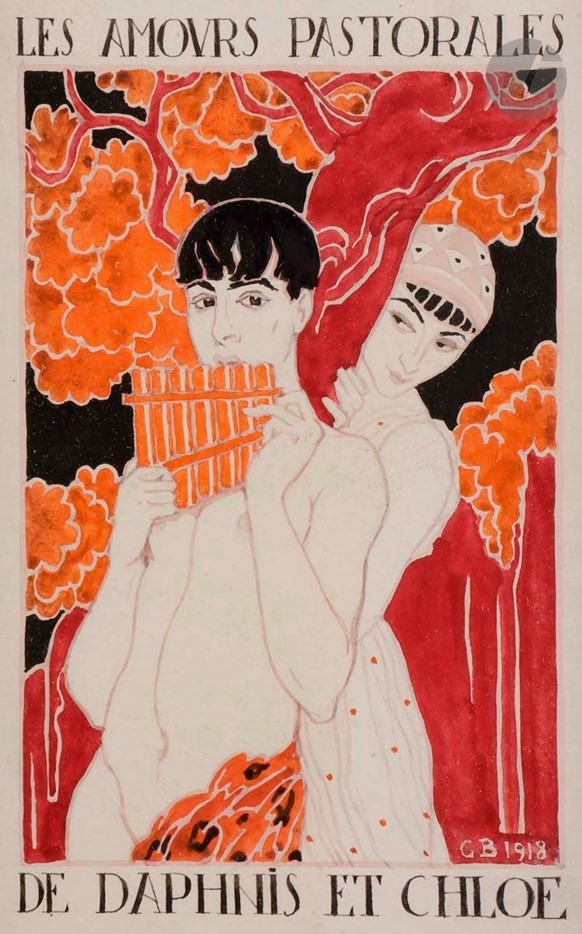
George Barbier, Les Amours pastorales de Daphnis et Chloé, 1918.
The subject of Daphnis and Chloe is distinguished from other Greek novels by its bucolic setting and the constant irony which governs the course of the action.
It is above all their sentimental education which is described throughout the adventures of the novel. The two protagonists live in the countryside, near the city of Mytilene on the islandof Lesbos. Daphnis is a young goatherd, a child found by shepherds (in a laurel grove, hence his name which comes from the ancient Greek δάφνη (daphnè), laurel). Chloé, for her part, is a shepherdess, also a foundling. They grow up in a pastoral setting and fall in love with each other, but multiple twists and turns prevent them from satisfying their love. However, the outcome is a comedy: the two children are recognized by their respective parents, who are rich people from Mytilene, lifelong friends, and who are going to marry them. (x)
#george barbier#1918#daphnis and chloe#Daphnis et Chloé#barbier#longos#roman de gare#illustration#Ancient Greek#Mytilene#lesvos#lesvos island#1918 illustrations#art#art history#lesbians#ancient#greek#homosexual#lgbtq community#lgbtq
33 notes
·
View notes
Text

me drawing my favourite ship as famous paintings ( 2 / ? ) ( this time it's 'springtime' by pierre auguste cot )
extra:

#art#2023#oc: archange#me when im like oh wait i should draw archange art that doesnt have scara in it#and then i dont#its ok its because my scrunkly beloveds#consider this a spiritual sequel to the one that's based on gérard's daphnis et chloe#i was on the fence abt actually posting this bc its so sickeningly self-indulgent im actually embarrassed bwahaha
14 notes
·
View notes
Text

Temple garden
#painting study loosely based on Daphnis et Chloe by Elizabeth Jane Gardner#dungeons and dragons#dnd#avira barlem#her fit in the last session#the party was at a temple and she has bandages because there was an accident in between sessions#the party was sailing and something happened...they woke up in an infirmary everyone bandaged up.#drown had lost an arm#it was honestly really heartbreaking and Drown was obviously in shock#Yona hugged her and Avira also tried to comfort her#Ogloth lost their pets in the accident :(#and one of the party members went missing
62 notes
·
View notes
Text
sometimes a piece of music is so beautiful and ethereal that you just have to stop everything and experience it
#music#art#songs#beauty#i was listening to daphnis et chloe by ravel#and i was like HOLY SHIT this is so beautiful it feels like i am a magical tree#piano
4 notes
·
View notes
Text
“ravel’s orchestrations are lush” incorrect. they are chewy. i want to gnaw on them like a dog. they are bitable.
1 note
·
View note
Text
The Round 1 Draw is here!

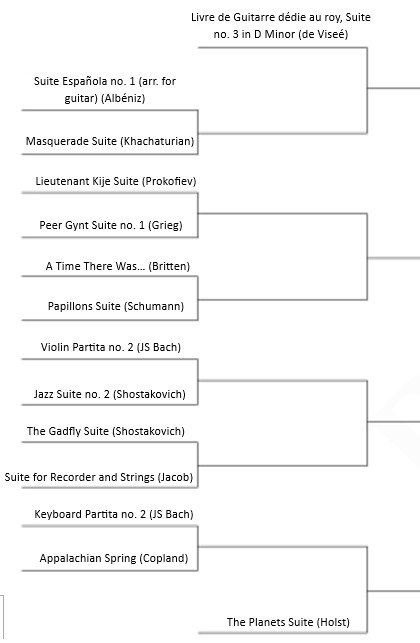

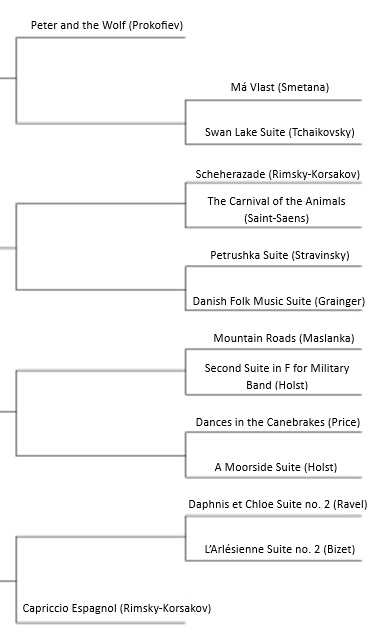
The top left:
Sleeping Beauty Suite vs Bye
Le tombeau de Couperin vs Suite in Old Style
Holberg Suite vs Lemminkäinen Suite
Caucasian Sketches Suite no. 1 vs Suite for Solo Viola
The Golden Mountains vs Carmen Suite no. 2
Lincolnshire Posy vs Der Rosenkavalier Suite
American Suite vs Cello Suite in G Major
Pictures at an Exhibition vs Children's Corner Suite
The bottom left:
Livre de Guitarre dédie au roy, Suite no. 3 in D Minor vs Bye
Suite Española no. 1 vs Masquerade Suite
Lieutenant Kije Suite vs Peer Gynt Suite no. 1
A Time There Was vs Papillons Suite
Violin Partita no. 2 vs Jazz Suite no. 2
The Gadfly Suite vs Suite for Recorder and Strings
Keyboard Partita no. 2 vs Appalachian Spring
The Planets Suite vs Bye
The top right:
Suite from Hamlet vs Bye
English Folk Song Suite vs Mother Goose Suite
Orchestral Suite no. 3 in D vs St Paul's Suite
The Firebird Suite vs Symphonic Dances
Romeo and Juliet Suite No. 2 vs Dance Suite
Giselle Ballet Suite vs Keyboard Partita no. 6
First Suite in E-flat for Military Band vs Magnificant in Bb Major
The Nutcracker Suite vs Violin Partita no. 3
The bottom right:
Peter and the Wolf vs Bye
Má Vlast vs Swan Lake Suite
Scheherazade vs The Carnival of the Animals
Petrushka Suite vs Danish Folk Music Suite
Mountain Roads vs Second Suite in F for Military Band
Dances in the Canebrakes vs A Moorside Suite
Daphnis et Chloe Suite no. 2 vs L’Arlésienne Suite no. 2
Capriccio Espagnol vs Bye
Please note all of these matches (including byes) were randomly allocated using a random number generator and I will not be making any changes. I will post 1 poll per day starting from 12:00 am GMT time on the 1st of December (in 24 hours time at time of posting), with each poll lasting for a week to give everyone time to listen to each submission.
35 notes
·
View notes
Text
Montparnasse and Éponine: Unpacking the Némorin quote
Victor Hugo makes reference to Némorin on two separate occasions in Les Misérables. Undoubtedly, the most interesting instance where the name is featured, or at least the most interesting instance to me, is when Montparnasse and Éponine abandon the Gorbeau ambush to sneak off together, and Montparnasse is described as “être Némorin”.
“Montparnasse en effet, ayant rencontré Éponine qui faisait le guet sous les arbres du boulevard l'avait emmenée, aimant mieux être Némorin avec la fille que Schinderhannes avec le père.”
As an individual captivated by the glimpses of dynamic we see between Éponine and Montparnasse in the novel, I find myself referencing this “Némorin” quote quite often (hell, I even use “Némorin” as a catch-all tag for Montparnasse and Éponine content on my blog!). However, I realise that I’ve never taken the time before to explain this quote and the allusions it makes, nor have I ever clarified properly who Némorin exactly is. So, this post aims to unpack all that— full ramble is below the cut!
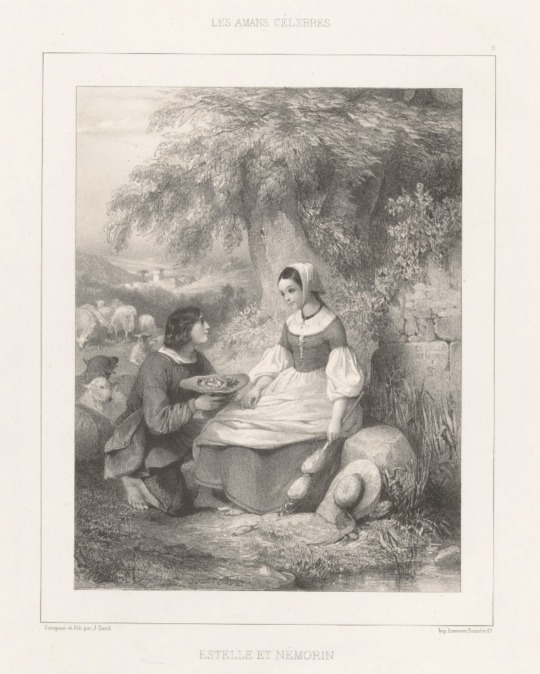
['Estelle et Némorin'. Jules David, 1841-1843. Source]
Literary Contexts: Estelle and Némorin
Let’s first delve into this character of Némorin who Montparnasse is compared to…!
To summarise, Némorin is one of the main characters in a wonderful and extremely popular French pastorale titled Estelle et Némorin, published in 1788 by Jean-Pierre Claris de Florian.
I’ve tried to read this full text before but unfortunately it’s rather difficult to find an easily available translated version in English, so I will only provide an overview of the story’s plot rather than include any direct quotes. Let me employ this helpful summary of the tale between these two lovers below:
“Inspired by Daphnis and Chloe and set at the end of the fifteenth century, the novel tells of the love of the shepherd Némorin for the beautiful Estelle. She returns his love but out of duty and gratitude is obliged to marry another shepherd, Méril, after he rescues her father. Némorin despairs but is saved by Méril's heroic sacrifice of his own life in battle, a sacrifice made so that the lovers might be united.” [Source]
The story’s popularity can be evidenced in many art pieces of the late eighteenth and early nineteenth-century. Look at these sweet paintings and prints of the couple below!

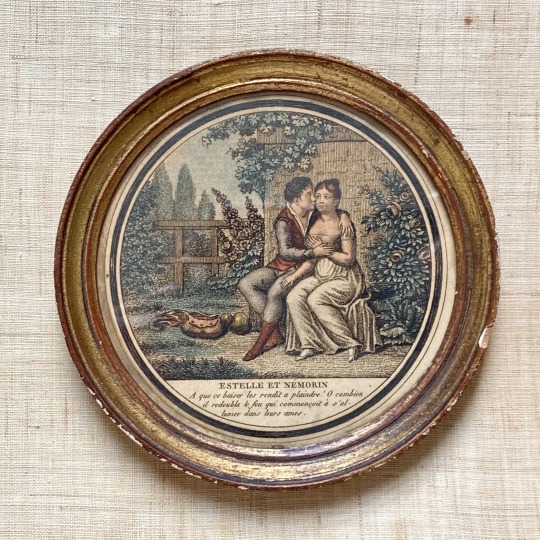

There even exists a lovely romantic fountain statue of Estelle and Némorin which was erected in 1896– evidencing that Florian's narrative certainly had a continued popularity far beyond its original publication in the eighteenth-century!

Like so many of the fleeting references sprinkled throughout Les Misérables, readership of the time would have likely been far more familiar with the character of Némorin than readers today are. There was even an opéra-comique made of this pastoral tale in 1876! And— combining that knowledge with the story’s general popularity at the beginning of the 1800s— I think it can be safely assumed that Estelle et Némorin would have been a very recognisable tale to the first readers of Hugo's novel back in 1862.
Némorin ultimately is an ardent romantic— a humble shepherd who adores his beloved Estelle, remaining loyal in his affections to her. With a starry-eyed devotion he pursues her, and filled with love he even etches her name into a tree… a detail that I find particularly fascinating since Montparnasse’s “Némorin” encounter with Éponine initially occurs under some trees lining the boulevard.
...But, if Némorin is a besotted lover, why would Hugo want to compare Montparnasse to him?
•
“Être Némorin”: Applying the context to Montparnasse
On the night of the Gorbeau ambush, instead of readying himself for the planned attack on Valjean from inside the tenement with the other rogues of the Patron-Minette, Montparnasse is mysteriously missing. When Thénardier asks Babet where this juvenile lead is, Babet explains that he has stopped for a “chin-wag” (Rose trans.) with Éponine.
We then find out in a later chapter that Montparnasse and Éponine were seemingly doing much more than just chatting that night, and it is at this point where Montparnasse and Némorin are compared:
“Montparnasse had, in fact, encountered Éponine as she stood on the watch under the trees of the boulevard, and had led her off, preferring to play Némorin** with the daughter rather than Schinderhannes with the father.” (Rose trans.)
**I think it is important to note that in the original French text, it is not worded as preferring ‘to play Némorin’, but instead ‘to be Némorin’. I personally find that there are distinct differences between this translated phrase and the phrase in original French, as ‘being’ Némorin seems to hold far more significance than ‘playing’ Némorin.
Basically, the TL;DR of the quote is thus— Montparnasse would prefer to be Éponine’s lover / he prefers to seduce Éponine than participate in criminal activities with her father. (Brief note; Schinderhannes was a real-life, internationally famous criminal from the eighteenth-century. I could go more into this comparison also but I don't want to get too side-tracked on this post. Although, I find it interesting that Montparnasse is compared to two starkly contrasted figures here, and it is typical of Hugo to use classical, literary, and real-life figures as symbolic vessels for certain concepts).
Incidentally, I suppose that in the context of this quote, Éponine would be the “Estelle” to Montparnasse’s “Némorin”. And yet, Montparnasse’s actions here do not sound like the behaviour of Némorin at all.
... Despite the comparison to this romantic figure, I don’t think Hugo is actually expecting Montparnasse to act like a loyal, devoted lover with the girl. Rather, I’m almost entirely certain that he is being purposefully sarcastic here!
I mean, c’mon, do we really think that Montparnasse and Éponine left the boulevard together to spend the evening sharing a love as innocent and chaste as Némorin and Estelle? Absolutely not! I think that their encounter was certainly a lot of lustful than that— especially reading between the lines when we find out that Javert arrested Éponine later that night but Montparnasse had disappeared and seemingly left her behind— which indicates to me that their night-time rendezvous was only temporary, and likely more similar to a hook-up.
Hugo’s comment on Montparnasse preferring to be Némorin does tell us something about his character traits (aka that he indulges in all distractions and vices, sometimes at the expense of participating in criminal heists), but ultimately I think that this line is just Hugo making a little tongue-and-cheek comment about Montparnasse being a flirt and alluding to him having a casual relationship with Éponine. Just like Montparnasse is a false dandy, we should read him as a false Némorin! He and Éponine are not true lovers by any means, but the quote does signify that they almost certainly have slept together and thus share a deeper connection than they do with other characters.
•
Additional Analyses
Okay— hear me out— but I think that the Estelle et Némorin concept can be further drawn out concerning Montparnasse and Éponine in later parts of the novel… not involving Némorin’s character specifically, but rather in relation to the wider narrative of Florian's pastorale and Hugo's Les Misérables…
We are told that Montparnasse is Némorin (albeit he is likely a satirical parody of the character) as he leads Éponine away from the Gorbeau tenement on the night of the ambush. But, to me, Montparnasse also partially seems to morph into another character of Florian’s story when the Patron-Minette escape from La Force at a later point in the narrative. This character’s name is Méril!
Who is Méril, I hear you ask? Well, he is the man that Estelle is originally expected to marry. He works with Estelle’s father and saved his life, which is why she is to be wed to him.
And, who do we see working with Thénardier through the Patron-Minette? Who “saves” Thénardier’s life when he tries to escape La Force? Who demands that the rest of the Patron-Minette hang around and search for his signal instead of abandoning him, waiting outside the prison in the rain until 4 o’clock in the morning? Who do we know is explicitly called Thénardier's “almost son-in-law” at one point in the novel?…
You guessed it: Montparnasse!
I find it important and extremely interesting to analyse these partial similarities between Montparnasse and Méril in terms of their actions, as it might be used to further explain Éponine and Montparnasse’s dynamic. It also emphasises my above suggestion that Montparnasse is not a genuine Némorin.
Additionally, I would like to briefly mention that the only other reference to Némorin that we get in Les Misérables is spoken by Gillenormand in a speech at Marius and Cosette’s wedding:
“Can there be too many perfumes, too many open rose-buds, too many nightingales singing, too many green leaves, too much aurora in life? Can people love each other too much? Can people please each other too much? Take care, Estelle, thou art too pretty! Have a care, Nemorin, thou art too handsome! Fine stupidity, in sooth! Can people enchant each other too much, cajole each other too much, charm each other too much? Can one be too much alive, too happy?” (Hapgood trans.)
Thus with Némorin being mentioned as an explicitly loving figure here at Marius’ wedding, I think we have finally found the real Némorin character of Hugo’s novel…!
Montparnasse is merely a pretender, a Méril in Némorin’s guise— but Marius’ personality is far more suited to be Némorin than Montparnasse is. And, of course, if we interpret Éponine as a sort-of Estelle (although, we should be mindful that Cosette is the “real” Estelle of this novel) we actually see her choose the “real” Némorin [Marius] over Méril / the “false” Némorin [Montparnasse] at rue Plumet, when she refuses to let Montparnasse and the rest of the Patron-Minette pass the gate and enter the house.
Of course, not all of the elements of Florian’s Estelle et Némorin match up to these characters and their actions— most notably the detail that Méril sacrifices his life for Némorin because he can see how much genuine love he has for Estelle, and how much genuine love she has for him— but I think there are some general similarities potentially at play between these two texts.
Although the “Némorin” quote is only fleeting, there is so much context hidden behind it which can help us to further understand Montparnasse’s character and his relationship with Éponine. Namely, Hugo’s tongue-and-cheek comparison between Montparnasse and Némorin when he sneaks off with Éponine undoubtedly suggests that there was more going on between the pair than we might first assume, even though they evidently do not harbour the same romantic, loving affections that Florian’s Némorin and Estelle do.
#montparnasse#eponine#eponine thenardier#les mis meta#les miserables#les mis#the brick#quotes#meta#historical context#literary analysis#némorin
47 notes
·
View notes
Photo

Gaston Renault (1855-1931) French
“ Daphnis et Chloe” 1881
117 notes
·
View notes
Note
What's your opinion on the funny Bolero man?
okay, I have a LOT of opinions on Ravel, and I’ve actually done quite a bit of research on him. He’s one of my favourite composers, and his life story just… god.
So the first thing I want to say about Ravel is that his music tends to be very easily misunderstood, and this is according to Ravel himself. Ravel is a toymaker, a tinker. He called himself “artificial by nature,” and that’s the key thing to understand. Ravel is artificial, but that’s not necessarily a bad thing; in fact, that’s part of his appeal and what makes his music unique. Much of the time, he’s not directly seeking to express an emotion, but rather a depiction, an imitation of one. It’s like he’s creating clockwork automatons of living things that are not meant to be lifelike, but to be clockwork. He imitates other composers in “A la Maniere de Borodin/Chabrier,” objects and animals in “L’enfant et les Sortileges,” and the styles of other cultures around the world across his body of work. On the subject of the last one, Ravel does often have a tendency towards Orientalism, which can be sometimes cringey in today’s social environment (“Chinoiserie” and a general fascination with the East was very much in fashion in his day), but I think Ravel’s impressions of Asian, Middle Eastern, and even European music (including Spain; Ravel was part Basque and was very proud of that) can be best understood when compared to Disney’s “Small World” ride. You’re not getting an authentic picture of the world; you’re getting a mechanical fantasy based on it.
I bring up machines a lot when I talk about Ravel, not just in reference to his music, but also to his life. Stravinsky referred to him as the “most perfect of Swiss watchmakers,” his father was in inventor (who was also responsible for creating a machine that resulted in a fatal mishap, aptly called the “Whirlwind of Death;” look it up), and he had a lifelong fascination with toys and mechanical objects. We see them prominently featured in his opera “L’Heure Espagnole,” the vocal piece “Noel des Jouets” (a little-known piece about the Nativity, except make it steampunk!), and of course, Bolero, which is perhaps one of the most misinterpreted Ravel works.
The thing about Bolero is it’s not supposed to be sexy. And many Ravel pieces are- Nahandove from “Chansons Madacasses” (a cycle which, I should add, also includes a striking rebuke of French colonialism in “Aoua”), Daphnis et Chloe’s Bacchanale, maybe even La Valse. However, Ravel stated that “Bolero should be played at a constant speed from beginning to end, in the plaintive, monotonous style of Arabo-Spanish melodies.” He considered it his only masterpiece, not because of its beauty or virtuosity, but because it achieved what he set out to write- a piece with “no form properly speaking, no development, no modulation, or hardly any.”
I think this is where misinterpretations of Ravel most commonly arise, when his artificiality is mistaken for genuine passion. Famously, with his “Pavane for a Dead Princess,” Ravel disliked interpretations that were too slow, remarking that “it’s a Pavane for a dead princess, not a dead Pavane for a princess.” While slow interpretations may intend to be elegiac, a steady tempo brings another meaning to the title- not that this Pavane would be heard at a princess’ funeral, but rather something that a princess from a past time would have danced while alive. And we can also connect this to the view of death Ravel takes in “Le Tombeau de Couperin,” a work with each movement dedicated to a friend who died in WWI (Ravel served as a nurse and supply truck driver). Despite being a memorial piece, “Le Tombeau” is largely joyful; the “Minuet” displays some sentimentality, but this work is largely dedicated to celebrating life, rather than mourning death.
Another thing to consider about Ravel was that he made his aesthetic his entire personality. And I’m dead serious about that. Ravel adopted the fashion style and philosophy of Dandyism, in which one was to make themselves stylish and presentable, while appearing detached and aloof from the rest of the world, keeping inner feelings private. Ravel was very particular about his personal appearance (he was once late to a funeral because he couldn’t decide which suit to wear!) and hardly divulged deeply personal information in his private correspondence- for instance, while it’s likely he may have been aromantic, as far as we know, we don’t have any evidence of Ravel having any committed romantic or sexual partners (although we do have a few accounts from other people claiming he sometimes saw prostitutes). He kept his passions and fears largely secret, and this is further reflected in his works; while he often dedicated them to friends and patrons, I can’t say I know of anything by Ravel that’s explicitly or otherwise proven to be biographical. As a composer, he takes a “Dandyistic” approach as well, giving us beautiful works while hardly allowing us a window into his mind.
One thing in particular about Ravel has haunted me, and that’s how he died. While he’d been showing signs of mental deterioration in years prior, in 1932, he got into a taxi accident, which likely accelerated what would be diagnosed as aphasia, although we still don’t know what exactly he had. For the next five years, Ravel would gradually become unable to read, write (both words and music), and play the piano, and sometimes had difficulty controlling his movements and recognizing people. Even prominent biographers like Roger Nichols express how devastating this period of Ravel’s life was, as his friends tried to make it, in Nichols’ words, “even remotely tolerable.” During this time, Ravel could compose in his head, but not write anything down, and was even planning at least two major works- an opera called “Jeanne d’Arc,” and a ballet called “Morgiane.” His friends took him on a trip to Morocco and he immensely enjoyed it, appearing to temporarily improve, but afterwards, his mental health continued to decline. Looking at Ravel’s correspondence from this time is devastating, as we see his handwriting get messier and messier, then only typewritten letters, and then nothing at all. At a performance of his ballet, “Daphnis et Chloe,” Ravel reportedly began to cry, remarking, “and yet, there is still so much music inside my head!”
Sources vary on whether or not Ravel was aware of the fact, but his brother Edouard arranged for him to have an operation with the famous brain surgeon Clovis Vincent. Afterwards, Ravel woke up from the surgery, asked to see his brother, but fell comatose, dying in his sleep on December 28th, 1937. Dr. Vincent reportedly did not find ant tumours.
… anyway, this ended up way longer than I expected it to be. but I really like ravel
#maurice ravel#ravel#classical music#music history#composers#composer#classical music history#french music history
41 notes
·
View notes
Text




#coquette#lana del rey#dollette#2014 grunge#girlblogging#femcelcore#2014 tumblr#woman of color#brandy melville#courtney love#femcel#floral#grunge#kinderwhore#marina and the diamonds#alternative rock#france#jfashion#90s grunge#ghost girl#angelcore#phantom#classical music#esoteric#Spotify
80 notes
·
View notes
Text
Photos from my Opera Garnier Trip 2 of 3
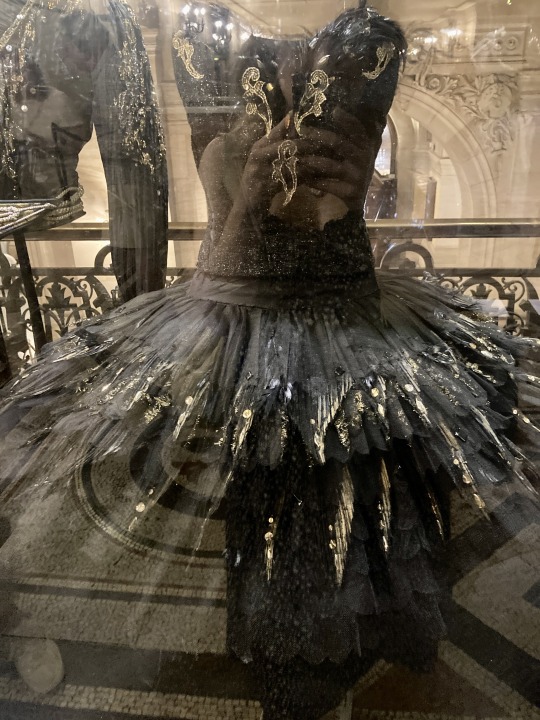
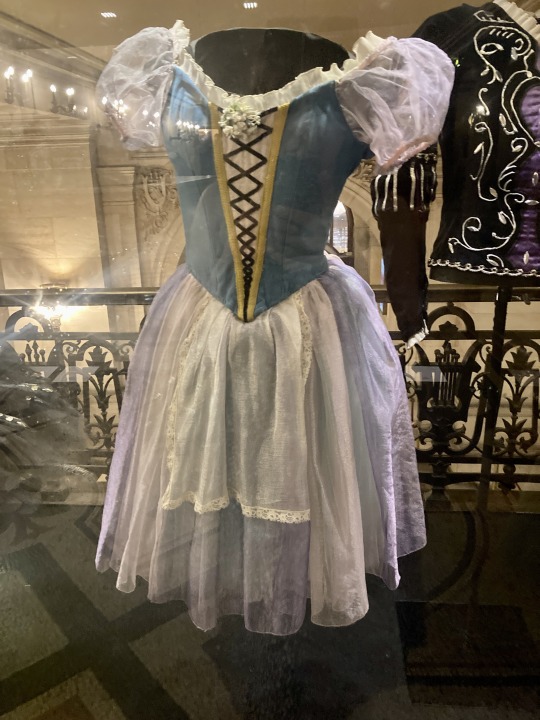

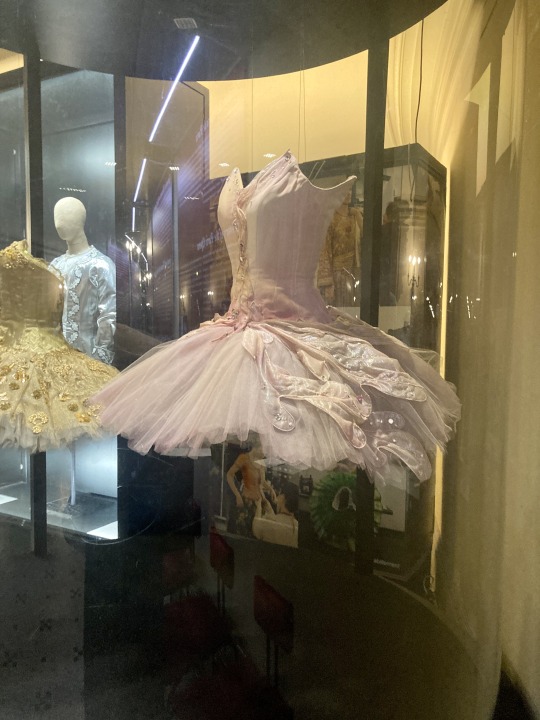
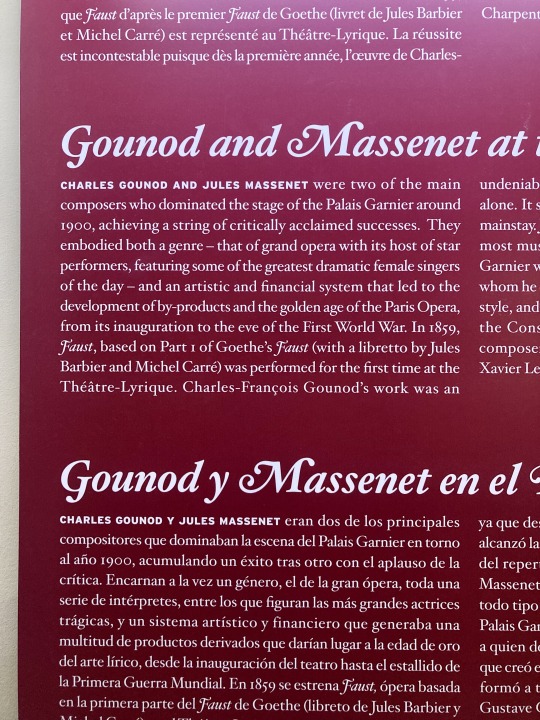
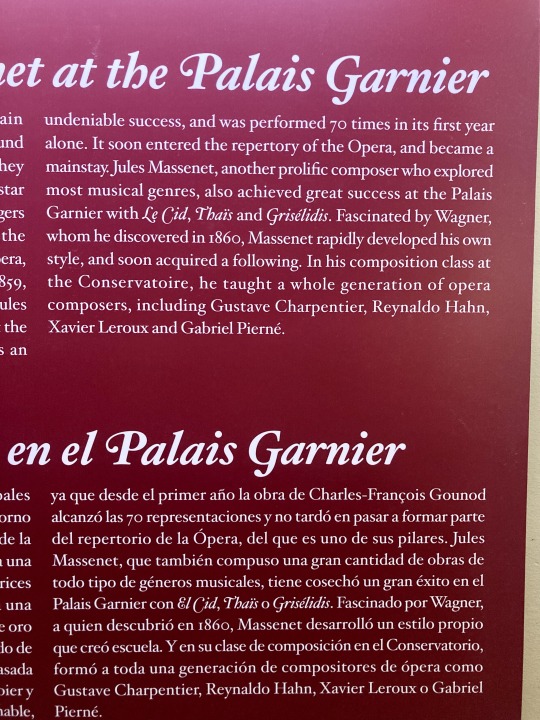
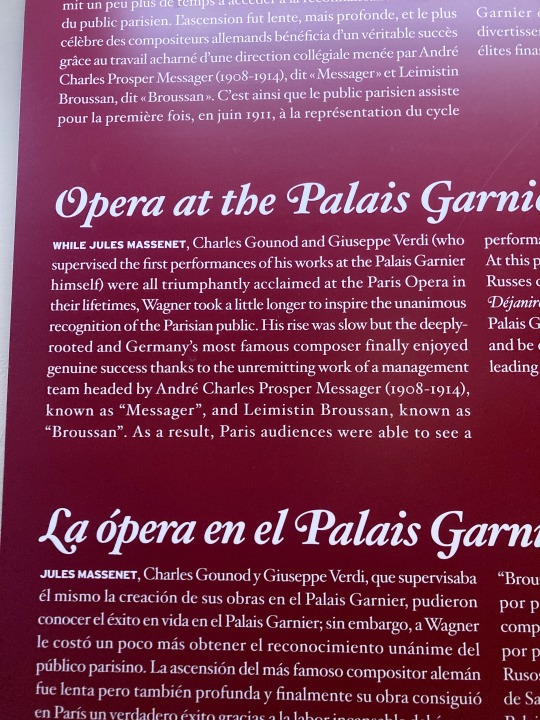

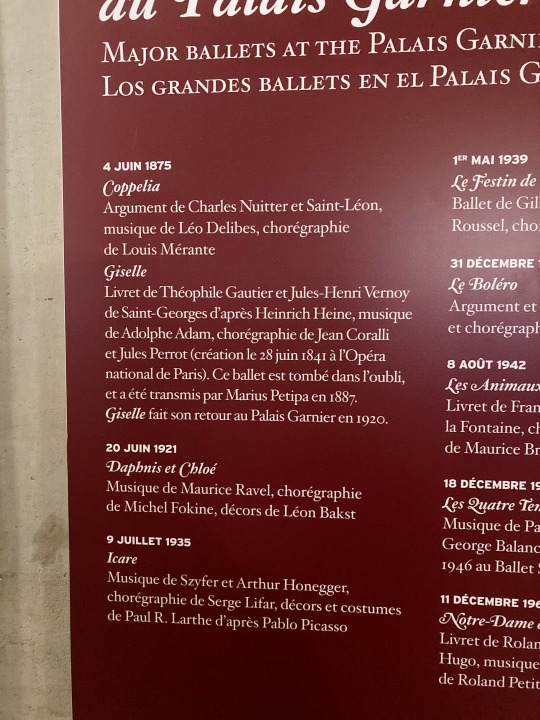


Took some photos of the exhibit up at the Opera Garnier for my own (cough cough) research purposes and thought it might be helpful for others! Thought the Don Quixote dress looked awfully familiar!
Transcript of the information under the cut:
Gounod and Massenet at the Palais Garnier
Charles Gounod and Jules Massenet were two of the main composers who dominated the stage of the Palais Garnier around 1900, achieving a string of critically acclaimed successes. They embodied both a genre - that of grand opera with its hoses of star performers, featuring some of the greatest dramatic female singers of the day - and an artistic and financial system that led to the development of by-products and the golden age of the Paris Opera from its inauguration to the eve of the First World War. In 1859, Faust, based on Part 1 of Goethe's Faust (with a libretto by Jules Barbier and Michel Carre) was performed for the first time at the Theater-Lyrique. Charles-Francois Gounod's work was an undeniable success and was performed 70 times in its first year alone. It soon entered the repertory of the Opera and became a mainstay. Jules Massenet, another prolific composer who explored most musical genres, also achieved great success at the Palais Garnier with Le Cid, Thais, and Griselidis. Fascinated by Wagner, whom he discovered in 1860, Massenet rapidly developed his own style, and soon acquired a following. In his composition class at the Conservatoire, he taught a whole generation of opera composers, including Gustave Charpentier, Reynaldo Hahn, Xavier Leroux, and Gabriel Pierne.
Opera at the Palais Garnier around 1900
While Jules Massenet, Charles Gounod, and Giuseppe Verdi (who supervised the first performances of his words at the Palais Garnier himself) were all triumphantly acclaimed at the Paris Opera in their lifetimes, Wagner took a little longer to inspire the unanimous recognition of the Parisian public. His rise was slow but the deeply-rooted and Germany's most famous composer finally enjoyed genuine success thanks to the unremitting work of a management team headed by Andre Charles Prosper Messager (1908-1914) known as "Messager", and Leimistin Broussan, known as "Broussan". As a result, Paris audiences were able to see a performance of the entire Ring cycle for the first time in June 1911. At this period, the Palais Garnier hosted Serge Diaghilev's Ballet Russes company, and Richard Strauss' Salome and Saint-Saens Dejanire both entered the repertory. During the Belle Epoque, the Palais Garnier was one of the chief places for Paris society to meet and be entertained, with an audience of subscribers made up of leading financiers, industrialists, and politicians.
Major Ballets at the Palais Garnier
4 June 1875
Coppelia - Argument de Charles Nuitter et Saint-Leon, Musique de Leo Delibes, choregraphie de Louis Merante
Giselle - Livret de Theophile Gautier et Jules-Henry Vernoy de Saint-Georges d'apres Heinrich Heine, musique de Adolphe Adam, choregraphie de Jean Coralli et Jules Perrot (creation le 28 Juin 1841 a l'opera national de Paris). Ce ballet est tombe dans l'oubli, et a ete transmis par Marius Petipa en 1887. Giselle fait son retour au Palais Garnier en 1920
20 Juin 1921
Daphnis et Chloe
musique de Maurice Ravel, choregraphie de Michel Fokine, decors de Leon Bakst
9 Jullet 1935
Icare
Musique de Szyfer et Arthur Honegger, choregraphie de Serge Lifar, decors et costumes de Paul R Larthe d'apres Pablo Picasso
13 notes
·
View notes
Note
I've only just started listening to classical music more in the last couple years (mainly MPR and their streams as background when I'm writing). Anyway I've definitely noticed I have a couple composers I favor, and I wonder if you could give your (more informed than mine) opinion about two of my faves: Schubert and Ravel.
oh certainly!!!! :D
first off!!! SCHUBERT!!!!! i love schubert. one of my faves as well!!!!!!!! the composer of so many lieder.... amazing symphonies... incredible chamber works.... and of course the mighty trout....
perhaps my favorite piece of schubert is his Death and the Maiden string quartet (no 14)
youtube
it's actually based on one of his lieder of the same nickname! (the second movement is a theme and variation on it, in fact!)
i also adore his string quintet. (not to be confused with the piano quintet, based on the trout. which is also an amazing piece!). what makes his string quintet special is he put 2 cellos instead of 2 violas. it gives the piece a different Feel from other string quintets. the second movement is incredibly beautiful!
anyway. i love schubert. i could go on forever about him. I will say though that i also love his piano works, especially the d960 sonata and the impromptus!
also the fact that he died at 31... it's so tragic.....
onto ravel!!! i also love ravel! the french impressionism musical movement was so full of color and emotion.... i enjoy the music of him and his contemporaries like debussy.
in case it was not obvious already. i am a massive fan of chamber music. so naturally my favorite ravel piece of all time is his string quartet
youtube
the entire piece is incredible, but my favorite movement is the second. it's so rhythmic and colorful and full of interest! the pizz stuff is just so fun. it's also clear that he was inspired by debussy's string quartet! which is a win for everyone imo
another work i am very fond of is miroirs! his other piano works are also nice as well, like gaspard de la nuit and tombeau de couperin
ravel's orchestral works are also so good... i think my favorite is daphnis et chloe. the mother goose suite is also a good one! and ofc i must mention the pavane for a dead princess .
anyway, those are my brief thoughts on those composers! :D i am curious which pieces from them are your favorites as well!
3 notes
·
View notes
Text
June 3, 1809
Couche at 12. Rose at 7. Tro. bu. Pas bien.¹ Sor. before breakfast to U. Fredrick; 1 rix dollar. Tro. usé.² Breakfast at 9. Read a romance, “Les Amour de Daphnis et Cloe,³” traduit du Grec de Longus par Arryot.⁴ This romance is supposed to have been written after that of Heliodorus (“Theagenes and Chariclea”). Dined on sugar, water, and bread. A promenade seul to Kongl. Djur Garden,⁵ about two miles. Returned sans aventure.⁶ Tea at 9.
1 Had drunk too much and did not feel well.
2 Too much used up.
3 So in the MS.
4 “The Amours of Daphnis and Chloe,” translated from the Greek of Longus by Arryot.
5 For Sw. Konigliga Djurgård.
6 Without adventure.
14 notes
·
View notes
Text

a little wanderange based on the composition of gérard's daphnis et chloe teehee
#art#2023#oc: archange#i actually could do more to this but i started it before i went to london last week and only finished last night#and ofc. actually drawn a bg instead of using a screencap LMAO im lazy#anyway. one of these days ill draw archange art that DOESNT feature scara sob
22 notes
·
View notes